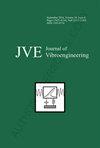Rolling bearing compound fault diagnosis based on spatiotemporal intrinsic mode decomposition
IF 0.7
Q4 ENGINEERING, MECHANICAL
引用次数: 0
Abstract
Aiming at the vibration signal characteristics of multi-channel rolling bearing complex faults containing various shock components, a rolling bearing complex fault diagnosis model based on spatiotemporal intrinsic mode decomposition (STIMD) method and fast spectral kurtosis method was proposed. The spatiotemporal intrinsic mode decomposition method combines the signal atomic decomposition method with the idea of signal blind source separation. Through the fast independent component analysis and the nonlinear matching pursuit method of the established overcomplete dictionary base, various fault mode components are separated. The initial phase function selected based on the high kurtosis fault frequency band obtained by the fast spectral kurtosis method can better fit the bearing fault frequency domain characteristics, so that the spatiotemporal intrinsic mode decomposition method can more accurately separate various impact components in the vibration signal. The simulation model of bearing compound fault was established and the data collected from fault diagnosis experiment platform were used to verify that the STIMD method was effective in solving the problem of rolling bearing compound fault diagnosis. By analyzing the kurtosis changes under different signal noise ratio (SNR) conditions and comparing the simulation results with the fast independent component analysis method, it shows that the kurtosis index decomposed by the proposed method is more able to prove the existence of faults under the condition of low SNR, that is, the impact is completely covered by noise. Therefore, a spatiotemporal intrinsic mode decomposition method with fast spectral kurtosis optimization can solve the problem of blind source separation in the field of composite faults of multi-channel rolling bearings and realize composite fault diagnosis.基于时空固有模式分解的滚动轴承复合故障诊断
针对含有多种冲击成分的多通道滚动轴承复杂故障的振动信号特征,提出了一种基于时空固有模态分解(STIMD)方法和快速谱峰度法的滚动轴承复杂故障诊断模型。时空本征模式分解法将信号原子分解法与信号盲源分离思想相结合。通过快速独立分量分析和已建立的超完全字典库的非线性匹配追求方法,分离出各种故障模式分量。根据快速频谱峰度法得到的高峰度故障频带选取的初始相位函数能更好地拟合轴承故障频域特征,从而使时空本征模态分解法能更准确地分离出振动信号中的各种冲击分量。建立了轴承复合故障的仿真模型,并利用故障诊断实验平台采集的数据验证了 STIMD 方法在解决滚动轴承复合故障诊断问题上的有效性。通过分析不同信噪比(SNR)条件下的峰度变化,并将仿真结果与快速独立分量分析方法进行比较,结果表明,在低信噪比条件下,即影响完全被噪声覆盖时,所提出方法分解的峰度指数更能证明故障的存在。因此,快速谱峰度优化的时空本征模态分解方法可以解决多通道滚动轴承复合故障领域的盲源分离问题,实现复合故障诊断。
本文章由计算机程序翻译,如有差异,请以英文原文为准。
求助全文
约1分钟内获得全文
求助全文
来源期刊

Journal of Vibroengineering
工程技术-工程:机械
CiteScore
1.70
自引率
0.00%
发文量
97
审稿时长
4.5 months
期刊介绍:
Journal of VIBROENGINEERING (JVE) ISSN 1392-8716 is a prestigious peer reviewed International Journal specializing in theoretical and practical aspects of Vibration Engineering. It is indexed in ESCI and other major databases. Published every 1.5 months (8 times yearly), the journal attracts attention from the International Engineering Community.
 求助内容:
求助内容: 应助结果提醒方式:
应助结果提醒方式:


